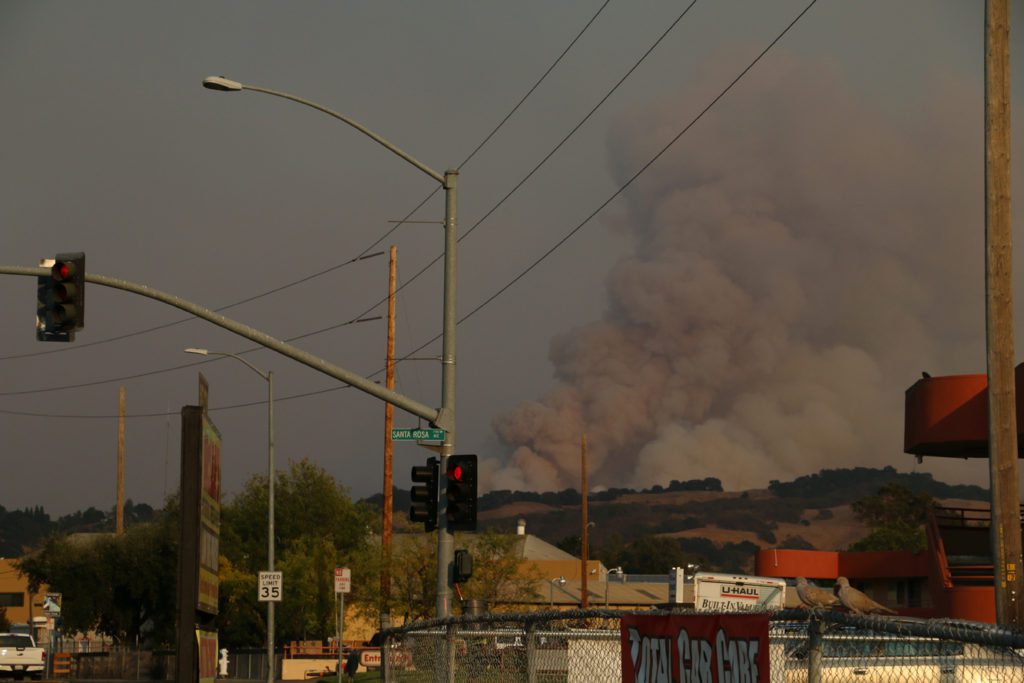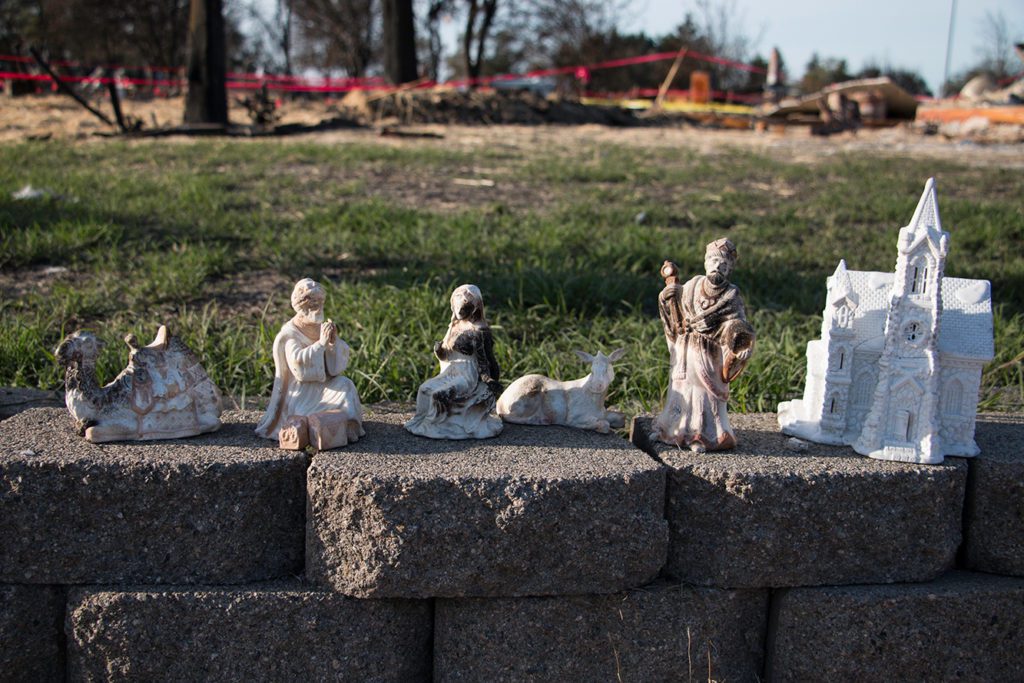Location: US Bay Area/Healdsburg
INTRODUCTION
IN NORTHERN CALIFORNIA, in the last five-plus years, the annual fire season has expanded from August to October, to May to December. Mandatory and suggested evacuations are part of our existence. Fear grows daily during the fire season. Though rain clouds may come, rain does not necessarily follow. The threat of dry lightning creates more stress, as it is one leading instigator of wildfires.

Smoke east from Santa Rosa Bennet Valley. Photo: Teresa Camozzi
I. OCTOBER 26, 2017, 11 PM
MY PARTNER STEPPED onto our deck overlooking the river canyon. It was very windy. He looked around for the source of an odd scent. The 2017 wildfire indiscriminately soared from Napa to Santa Rosa, jumping the 101 freeway into the Coffey neighborhood. What we smelled was plastic, metal, paper, and everything else on fire–all combining to create an unbreathable poisonous gas.
Over the next few days, we visited neighbors to hear their evacuation plans. Then we fled our home. I lost sleep checking my computer all night to check if my home and my friends were safe, and seeking information on the fire’s progress.
We live on a narrow road in a small cabin overlooking the Russian River, now small too because of the drought. Our home is shared with three ancient Redwood fairy rings. About August, they start to shed their brown ignitable skin. We furiously rake and rake, and blow it off our rooftop, and cut down trees with a propensity to light up. Then a few days later, we did it again.
The historic 2017 wildfire, called the Napa/Coffey/Tubbs fire, rose in the night. Families fled with less than a few minutes to hit the road, with hundreds abandoning all they owned. It spread from Calistoga and Napa through mountainous terrain into Santa Rosa proper.
II. 2017 CAL FIRE STATS
https://www.fire.ca.gov/incidents/2021/
1,548,429 Estimated Acres Burned
9,270 Wildfire Incidents
47 Fatalities
10,280 Structures Damaged or Destroyed
FOR THE LAST FOUR years, fire maintenance and evacuation plans are uppermost in our consciousness as the local Fire Department issues warnings to residences to comply with their expert demands. We even have hired goats to eat shrubbery! I never expected the bliss we have in our little mountaintop neighborhood would change to half a year of danger and foreboding.
Many neighbors have now left, hoping to find another home away from the effects of global warming. However, a core of us have stayed, becoming watchful and super-responsible. Forget bar-b-ques! We are now dedicated to safety, getting everyone off the mountain in time on one singular twisting road. My union with neighbors has grown more familiar and caring, which pleases me.
I recall Life Magazine printed an image of two people looking at small photos on ad hoc bulletin boards. The couple were looking for their brother, sister, mother, father, uncle, family, friends, and neighborhood, those photographed before being killed by the Khmer Rouge for being a Cham. When I was perhaps 12 or 14 years old, this single image represented clarity, anguish, a whole story I could feel without being there. This singular image has been with me all my life. I never knew it would be transformative later in my career.

The middle-class Wiki-up area is completely flattened by the fire. Here the bones of a swing reveal the northern side from the communal garden where homes were burned in the hills above. Photo: Teresa Camozzi
III. THE 2017 WILDFIRE AFTERMATH — COFFY/MARK WEST
LIVING ONLY A FEW miles from the 2017 Sonoma County Tubbs, Coffey Wildfire inspired me to shoot in a documentary manner for the first time. I had to learn quickly. As an artist, most of what I do is invent; how to get from where I am to where I want to be is an invention in my mind, so here was my challenge. The land and homes laid barren with silhouettes of found objects, blackened trees, missing garage doors. Bathtubs were strewn by explosions, prefab showers upside down. A million shapes were violently thrown together. The fire aftermath was a war zone.

This was once a gun store across the street from a mobile home park. Ammunition was exploding for hours. Photo: Teresa Camozzi
The Coffy area where firefighters saved the trailer park across the street but not the gun store here documented a few days later.
I learned firsthand how fire could kill and destroy. Our communities lost 47 human lives and hundreds of acres of flora and fauna. And the aftermath created a dangerous toxic pool.
One creative solution was the construction of netted bales stuffed with mushrooms and straw to function as contamination filters (provided free to fire residents). Bales were made in anticipation of the impending rainy season. Rain forced ash and home bi-products downhill where the bales were placed to absorb toxins to protect the water supply and prevent further land erosion.
The air had no filters, though. For months, watery eyes and coughing were the norm. Neighbors had even more trouble just trying to survive in shelters with children and pets until they could rebuild.
My Fire Aftermath documentary project grew into a three-year project. Christmas 2017 revealed shared love and care throughout the damaged neighborhoods. Survivors erected Christmas trees, solar lights, ribbons, and holiday socks to fill. One favorite sign read, “Don’t use the chimney Santa”!
In spring 2018, tiny green plants emerged through the ash. Narcissus bloomed white in brilliant contrast to the surrounding black. Destruction remained the pervasive imagery– an untouched, haunting scene, as if we had landed on the wrong planet. Photos revealed some homes leveled next to others untouched.
Summer brought owners to claim what was left. Lowes stores and the Boy Scouts made free screens to enable searches of metal and ceramic. In one circumstance, after shaking through the net, jewelry was found, laid out and left behind.
Coffy and Wiki Up residents and other compassionate folks erected broken and burned ceramic figures into tableaus, providing comic relief.

During Christmas, here in the Coffy district of Santa Rosa, people left memories of Holidays past. Photo: Teresa Camozzi
IV. 2018
THE SONOMA COUNTY Art Museum in Santa Rosa created a first-anniversary group art exhibit about the fire, and survivors’ resilience. Curator and director Jeff Nathenson commissioned me to use my fire photographs to create a printed silk mobile to hang from the center ceiling. Images included flora, fauna, and the detritus of fire. Now the mobile resides at the Finley Center in Santa Rosa.

I had the privilege of meeting The family who lost their home of fifty years. This was the home they had children, married their children, 50 years of holidays, birthdays, the ups and downs of growing a large family. Gino in the Santa suit here is helping the family to decorate as in years before. Since this photo they have re-built but smaller than before. Photo: Teresa Camozzi
Ecologically concerned, we acknowledge wildfire as a natural phenomenon. It is a fundamental component of an Earth System ecological process at once ancient, essential, and inevitable. Fire produces power and new growth. As creatives we also acknowledge fire as a concept, an element, an informing principle, a deity, a metaphor, an allegory, a creation story.
The Greek god Prometheus stole fire for humans from the gods. He could not see into the future when global warming and fire rode in the same saddle. Here we live in an earthly paradise, where we must seek sustainable knowledge and tools to mitigate future wildfire disasters–all part of working towards a healthier planet.
WEAD MAGAZINE ISSUE No. 12, TAKING ACTION
Published October 2021
